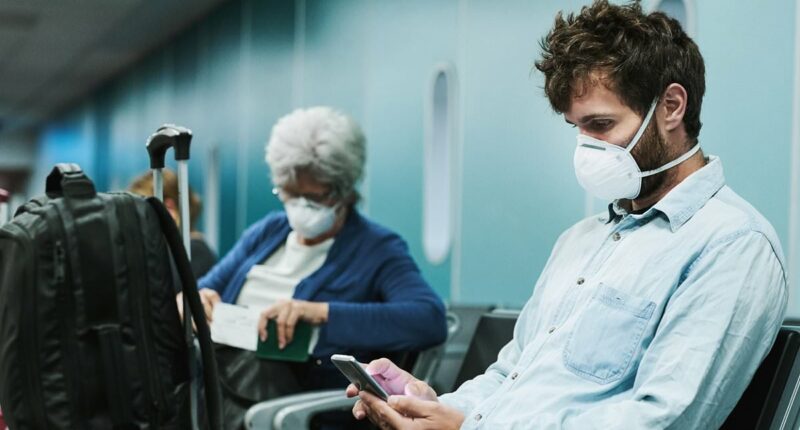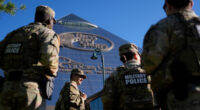Share this @internewscast.com
The upcoming pandemic is predicted to start with the demise of one infant in Africa and could potentially result in the deaths of more than seven million Americans, with worldwide casualties reaching a figure 20 times higher.
That’s the chilling conclusion of a ‘thought experiment’ carried out by leading US epidemiologist Michael T Osterholm.
More horrific still, this catastrophe is currently unavoidable. ‘The Big One,’ he says, ‘is not optional.’
Professor Osterholm, who was a prominent advocate for vaccines during the COVID pandemic, serves as the founding director of the Center for Infectious Disease Research and Policy.
Deeply concerned, the 72-year-old, also recognized for aiding in the containment of the 2014 Ebola outbreak, is now employing apocalyptic rhetoric more commonly associated with religious zealots rather than medical professionals.
In his new book The Big One, he says the next global epidemic will be ‘like a biological bomb going off… The world will once again be on fire.’
If this seems akin to a nuclear disaster forecast, Osterholm cautions that the consequences of a full-blown pandemic—something that’ll dwarf COVID as a mere practice drill—could exceed those of any atomic explosion.
“We invest billions of dollars annually,” he notes, “on national defense and security in the United States, yet pandemics have claimed more lives in recent history than all the wars combined.”

Osterholm emphasizes the necessity of vigilance regarding new and deadly disease strains transitioning from animals to humans (illustrated by: a wet market in Hong Kong).

The most likely sources of infection are not only bats but pigs and poultry, says Osterholm

Disinfecting a wet market in Huzhou City, China, in December 2021
‘It is no exaggeration to say that each of us remains in far greater constant danger from microbial enemies than from human ones.’
Osterholm refuses to commit himself on the question of what triggered the COVID-19 explosion – whether it was a zoonotic disease that crossed over from bats and possibly other animals, or a man-made contagion that escaped from a lab at the Wuhan Institute of Virology in China, where scientists were supercharging viruses with ‘gain-of-function’ powers.
Whatever the truth of that case, he says, we have to be constantly alert for new and lethal strains of disease making the leap from the animal kingdom. The most likely sources are not only bats but pigs and poultry.
Monkeys, too, could harbor sicknesses as yet unknown in humans, to which we will have little or no resistance. One emerged nearly 80 years ago in Uganda’s Zika forest, a flavivirus that at first seemed comparatively harmless.
It caused mild rashes, conjunctivitis and muscle pains – but 10 years ago scientists discovered it was capable of setting off Guillain-Barré syndrome, a paralyzing autoimmune disease.
One outbreak in Brazil also caused babies of infected mothers to be born with microcephaly, their heads abnormally small with brains that did not develop properly.
As an illustration of how varied the dangers of zoonotic diseases can be, Osterholm begins his ‘thought experiment’ with a respiratory infection transmitted to humans from camels.
This is not fanciful. In 2012, a coronavirus outbreak dubbed Middle East respiratory syndrome [MERS] appeared in the Arabian Peninsula – spread by camels.
MERS was terrifyingly deadly. Osterholm believes COVID-19 had a fatality rate around 3.4 per cent. But the death rate of MERS was 10 times higher, about one in three.
Thought experiments, a favorite device of Albert Einstein, are a way of testing hypothetical ideas. In military circles, they are also known as ‘war-gaming.’
The purpose of the exercise is to emulate a pandemic from first infections to mass lockdowns, and discover the best responses so that, when we are next faced with a potential international medical emergency, the world is better prepared to cope.
One thing we learned from COVID is that some people may get ill yet never pass the virus on to anyone else. Others are ‘super-spreaders’ – entirely by accident, they convey the disease to dozens, perhaps even hundreds or thousands of other people.

Professor Osterholm was one of the most strident voices in favor of vaccines to combat COVID during the last pandemic

Osterholm begins his ‘thought experiment’ with a potential respiratory infection that is transmitted to humans from camels

In his nightmare scenario, the children of poor farmers are first to be impacted by the mysterious, flu-like illness
In the worst case scenario, they will transport the virus to another continent. This accelerates the rate of spread far beyond anything that was imaginable even 100 years ago.
Osterholm’s imaginary outbreak starts on the border of Kenya and war-torn Somalia. Subsistence farmers, scratching a living from the drought-stricken land and constantly at the mercy of marauding gangs of soldiers, frequently see their children die of cholera, measles and dengue fever.
But the sickness that spreads through one community is different, more like flu. It brings chills, a hacking cough, aching muscles and a persistent, dull pain in the head.
The local health worker can do little except advise sufferers to drink plenty of water and rest as much as they can. For the farming families along this parched borderland, both those notions are impossible.
To make life more difficult still, several are seeing their camels sicken and die. These animals not only help to grind corn and pump the wells, and carry produce to market, but also provide milk. Their loss is a terrible blow.
As she visits each village, the health worker has no idea that she is carrying the virus herself. She is the first super-spreader. Many of the mothers whose babies she helps deliver, and the children she vaccinates, will catch the contagion from her.
But the mysterious illness is already moving beyond the village. One family whose crop has failed decide to make the arduous trek to a refugee camp on the other side of the border, 50 miles away. On the way, their baby develops a constant, racking cough. Three days after they arrive at the camp, she dies.
This imaginary scenario is all too plausible. The virus, so far undiagnosed, is a variety of MERS. How it arrived in the village can hardly be guessed, but perhaps it came from the wild, with contact between domesticated and untamed camels.
It was then transmitted to humans through dung or saliva (camels are great spitters). Viral crossovers like this are probably not uncommon but rarely spread. The difference in this hypothetical scenario is that the contagion mutated, becoming transmissible through the air – not necessarily in droplets or by touch. People were becoming infected simply by breathing the virus in.

The hypothetical health worker unknowingly picks up the virus and spreads it across villages

Mask precautions during COVID, says Osterholm, were largely useless

The only effective protection, says Osterholm, is via a certified N95 respirator
It was this, Osterholm believes, that made COVID-19 so virulent. For a long time, most doctors refused to believe the coronavirus was being passed from one person to another through the air.
They thought it was a contact disease, caught from particles of spittle when people stood and talked too close to each other. During the early stages of the pandemic, official advice was for everyone to wash their hands frequently, to reduce the risk of infection by touch, and to wear paper masks, to prevent airborne droplets from being breathed in and out.
Both these precautions were largely useless. Osterholm urges that the only effective preventative is to wear a certified N95 respirator, a plastic breathing apparatus similar to gasmasks worn during World War II.
He recognizes how extreme this will seem to most people, including those working in hospitals and any place where large numbers of people are gathered – such as a refugee camp.
‘You can change your behavior and cut back on bad habits to promote health,’ he says, ‘but you can’t cut back on breathing – so the idea of catching something just by inhaling is terrifying.’
In his ‘thought experiment’, of course, no one at Hagadera Refugee Camp in Kenya has access to N95 respirators.
The disease brought into the city of tents by one desperate family with their dying baby quickly spreads, with the hospital as its epicenter.
Several of its doctors live in the capital Nairobi, in its Eastleigh district.
They take the virus home with them, and soon it is rampant throughout the city. The hot, crowded buses making the seven-and-a-half hour journey between Eastleigh and the refugee camp act as petri dishes for the disease.
And it is becoming more deadly.

The terrifying vision of the ‘Big One’ pandemic spreads to the crowded Hagadera refugee camp in Kenya

An infected aid worker heads home to the US – but a warning from authorities about the danger of the new virus comes too late, says Osterholm in his ‘thought experiment’

Meanwhile, a businessman heads back east, setting the stage for what the author describes as ‘a biological bomb’

Highly contagious during its incubation period when it is undetectable, it then rapidly becomes very serious.
Nairobi’s hospitals are quickly overwhelmed. In up to a third of cases, the disease is fatal.
By now, the mysterious sickness has a name: sudden acute respiratory distress syndrome, or SARDS.
European and American health authorities start warning of the consequences if SARDS goes worldwide. They are already too late.
One French aid worker is at the end of his stint in Hagadera when he contracts SARDS. Without knowing he is infected, he travels back to Europe, passing first through Charles de Gaulle airport in Paris and then across the national rail network – spreading a trail of disease that infects hundreds of people.
At the same time, an Indonesian businessman concludes his deal in Nairobi and jets home, via Istanbul. Within hours, this highly infectious disease is spreading across the Middle East and south-east Asia.
Before US authorities can take action to limit international travel, a man presents at the emergency room in Minnesota.
Horrified medics diagnose SARDS. The man is placed immediately in an isolation room, but the hospital’s protocol does not mandate for N95 respirators. Staff and patients are inevitably exposed to the disease at its most virulent and contagious.
But that’s far from the worst of it.
The man describes his recent journey from Somalia to the US: 300 miles by truck to the capital Mogadishu, then flights from three successive airports, taking him to Qatar, then to Dallas Fort Worth, through US Customs and Immigration, and finally to Minneapolis–St. Paul.
In crowded queues for security, boarding, customs, and immigration, he has stood close to more than 1,000 passengers bound for the US.
SARDS has arrived. Before the epidemic is over, it will have killed as many people in the USA alone as died on all sides on the battlefields of World War I.
When Professor Michael T Osterholm says this is The Big One – he means it.
The Big One: How we must prepare for future deadly pandemics, by Professor Michael T Osterholm and Mark Olshaker, is published by Little, Brown Spark













